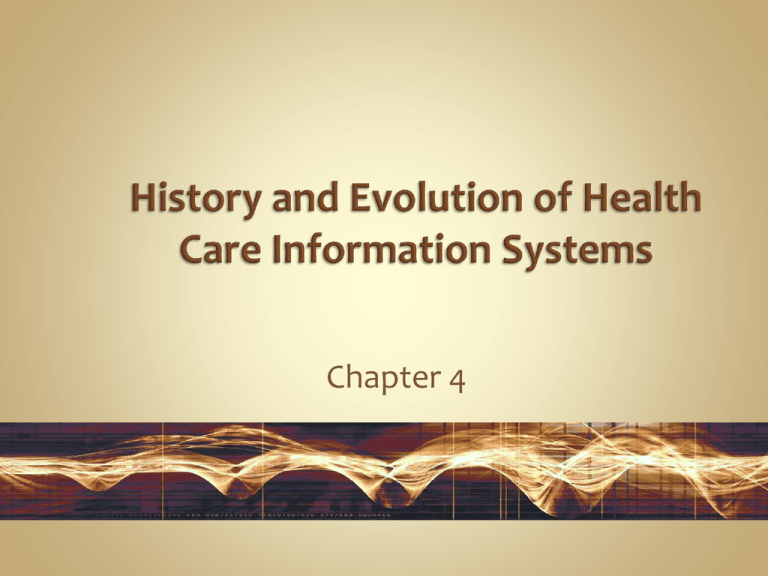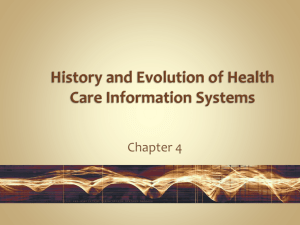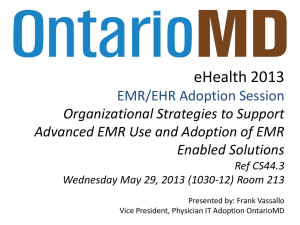History and Evolution of Health Care Information Systems
advertisement

Chapter 4 Describe the history and evolution of health care information systems from the 1960s to the present. Identify the major advances in information technology and significant federal initiatives that influenced the adoption of health care information systems. Identify the major types of administrative and clinical information systems used in health care. Discuss why information technology adoption rates are lower in health care compared with other industries. Discuss the relationship between incentives and health care IT adoption and use. • Definition of Terms – Information systems & technology – Health care information systems • Administrative applications • Clinical applications • History and Evolution of HCIS (from 1960s until now) – Health care environment – State of information technology – State of health care information systems • Information system—an arrangement of— – Data – Processes – People – Technology that interact to collect, process, store, and provide as output the information needed to support the organization. Administrative information system Contains primarily administrative or financial data Used to support the management functions and general operations of the health care organization Clinical information system Contains clinical or health-related information relevant to the provider in diagnosing, treating and monitoring the patient’s care Patient administration systems Admission, Discharge, and Transfer Registration Scheduling Patient billing or accounts receivable Utilization management Financial management systems Accounts payable General ledger Personnel management Materials management Payroll Staff Scheduling • Ancillary information systems – Laboratory – Radiology – Pharmacy • Other clinical information systems – Nursing documentation – Electronic medical record (EMR) – Computerized provider order entry (CPOE) – Telemedicine and telehealth – Rehabilitation service documentation – Medication administration What was happening in the health care environment and at the federal level that influenced organizations to adopt or use computerized systems? What was the state of information technology at the time? How did the environmental factors, coupled with advances in information technology, affect the adoption and use of HCISs? Health care environment + State of information technology = Use of health care information systems • Health Care Environment – Enactment of Medicare & Medicaid – Cost-based reimbursement – Building mode – Focus on financial needs and capturing revenues • State of Information Technology – Mainframe computers – Centralized processing – Few vendor-developed products Administrative and financial systems Used primarily in large hospitals and academic medical centers Developed and maintained in-house Shared systems available to smaller hospitals Data processing was primarily centralized on mainframe computers Health Care Environment Time of hospital growth and expansion Medicare and Medicaid expenditures rising Need to contain health care costs State of Information Technology Mainframes still in use Minicomputers become available, smaller and more affordable Turnkey systems available through vendor community Increased interest in clinical applications (particularly in ancillary departments) Shared systems still used • Health Care Environment – Medicare introduces prospective payment system for hospitals – Medicaid and other private insurers follow suit – Need for financial and clinical information • State of Information Technology – Unveiling of the microcomputer (PC) – Advent of local area network • • Distributed data processing Expansion of clinical information systems in hospitals • Physician practices introduce billing systems • Affordable, powerful computers now available to smaller organizations • Ability to integrate financial and clinical information becomes increasingly important Health Care Environment Medicare changes in physician reimbursement Health care reform efforts of Clinton administration Growth of managed care and integrated delivery systems IOM calls for adoption of computer-based patient record State of Information Technology Unveiling of the Internet (World Wide Web) Internet revolutionizes how organizations communicate with each other, market services, conduct business Cost of hardware drops Health Care Information Systems Health care organizations take advantage of Internet Vendor community explodes Wide range of HCIS products/services available Growing interest in clinical applications Still relatively small growth in adoption of CPR/EMR systems Health Care Environment IOM reports on patient safety and medical errors HHS calls for standards for EHRs Spiraling health care costs Economic upheaval and growing number of uninsured Health care transparency and pay for performance New administration Federal stimulus money available for HIT State of Information Technology Internet use moves to new level Voice recognition rebounds Bar coding and RFID PDAs and multipurpose cell phones PHRs and consumers maintaining Web-based records Web 2.0 technologies Health Care Information Systems National call for EHR adoption Infusion of HIT funding Office of the National Coordinator for HIT (ONC) Regional health information organizations Health care organizations struggle with how to successfully implement point of care clinical systems CPOE EHR E-prescribing Challenges of health care environment, coupled with advances in information technology, led to state of health care information systems Important to look at where health care industry has come in its adoption and use of IT and where it has yet to go











